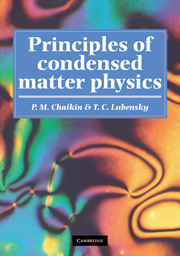Book contents
- Frontmatter
- Contents
- Preface
- 1 Overview
- 2 Structure and scattering
- 3 Thermodynamics and statistical mechanics
- 4 Mean-field theory
- 5 Field theories, critical phenomena, and the renormalization group
- 6 Generalized elasticity
- 7 Dynamics: correlation and response
- 8 Hydrodynamics
- 9 Topological defects
- 10 Walls, kinks and solitons
- Glossary
- Index
5 - Field theories, critical phenomena, and the renormalization group
Published online by Cambridge University Press: 05 June 2012
- Frontmatter
- Contents
- Preface
- 1 Overview
- 2 Structure and scattering
- 3 Thermodynamics and statistical mechanics
- 4 Mean-field theory
- 5 Field theories, critical phenomena, and the renormalization group
- 6 Generalized elasticity
- 7 Dynamics: correlation and response
- 8 Hydrodynamics
- 9 Topological defects
- 10 Walls, kinks and solitons
- Glossary
- Index
Summary
Mean-field theory, presented in the preceding chapter, correctly describes the qualitative features of most phase transitions and, in some cases, the quantitative features. Since mean-field theory replaces the actual configurations of the local variables (e.g. spins) by their average value, it neglects the effects of fluctuations about this mean. These fluctuations may or may not be important. The more spins that interact with a particular test spin, the more the test spin sees an effective average or mean field. If the test spin interacts with two neighbors, the averaging is minimal and the fluctuations are large and important. The number of spins producing the effective field increases with the range of the interaction and with the dimension. Thus we will find that mean-field theory is a good approximation in high dimensions but fails to provide a quantitatively correct description of second-order critical points in low dimensions. This chapter will be devoted to the study of second-order phase transitions when mean-field theory is not a good approximation.
We will begin by considering fluctuations of the order parameter about its spatially uniform mean-field value. We will find that for spatial dimensions below an upper critical dimension dc (typically dc = 4), fluctuations always become important and invalidate mean-field theory for temperatures sufficiently close to Tc. This will motivate a generalization of Landau theory that incorporates spatial fluctuations about a mean-field free energy minimum.
- Type
- Chapter
- Information
- Principles of Condensed Matter Physics , pp. 213 - 287Publisher: Cambridge University PressPrint publication year: 1995



